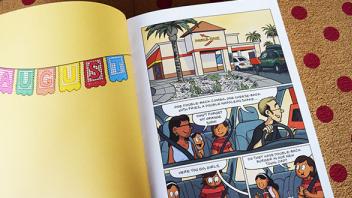What are graphic novels?
Graphic novels are stories written and illustrated in the style of a comic:
- Vivid illustrations combine with short bursts of text, often presented in a series of rectangular panels
- The story unfolds in a clear sequence, and is often action-packed (and funny)
Graphic novels can be fiction (for example: historical fiction, fantasy, science fiction, fairytales) or nonfiction (for example: history, biography, informational)
The main characters don’t have to be superheroes!
Are graphic novels “real books”?
Yes! Graphic novels are widely accepted by youth librarians and teachers as books worth reading by kids of all ages and reading levels. Top children’s publishers now offer graphic novels that are high quality (with strong characters, vocabulary, and storylines) and appropriate for young readers.
Popular authors who have published graphic novel series include: Jennifer Holm and Matt Holm (Babymouse and Squish), Shannon Hale (Rapunzel’s Revenge), Jarrett Krosoczka (Lunch Lady), Raina Telgemeier (Ghosts and Smile), Gene Yang (Secret Coders), James Burks (Bird and Squirrel), Jeff Smith (Bone), and Scott Morse (Magic Pickle).
How graphic novels help build children’s literacy skills
Reading motivation. Graphic novels are very popular, and especially appealing to readers who may not pick up a more traditional book on their own. They can be a “welcoming door” for reluctant or struggling readers (especially boys) who are drawn to the lively storylines and illustrations, and the smart but limited text. Quick, fun reads build confidence!
Visual literacy. The pictures in graphic novels are expressive, simple, and rich all at the same time. The images provide big clues about character and plot and encourage readers to look closely. Some graphic novels (such as Owly and The Adventures of Polo) are wordless, so the pictures must carry the full story.
Story structure. Most graphic novels for young readers have easy-to-follow plots. This can help children learn about how a story is stitched together. After sharing a graphic novel together, ask your child to tell you the basic plot of the story: “First this happened, then this … and at the end …”
Word learning for struggling readers and English language learners. Although individual words in a graphic novel can be sophisticated, the side-by-side Illustrations and text provide strong clues to their meaning.
Don’t forget to share graphic novels together — they make great read alouds!
Where to find great graphic novels for kids
Take a look at our booklist, Graphic Novels: Read the Pictures, for recommended reads. Or, browse these lists from the American Library Association — and ask the children’s librarian at your local library for more recommendations.
Expose your kids to the world of graphic novels through different genres. Here are some of our favorites:
Biography and memoir
- El Deafo by Cece Bell
- Smile and Sisters by Raina Telgemeier
- Elizabeth Cady Stanton: Women’s Rights Pioneer by Connie Colwell Miller
- March Trilogy by John Lewis and Andrew Aydin (for older readers or to read together)
Historical fiction
- One Dead Spy (Nathan Hale’s Hazardous Tales series) by Nathan Hale
Mystery
- Secret Coders by Gene Yang
Folktales, fairy tales and myths
- Rapunzels’s Revenge by Shannon Hale
- The Lightning Thief: The Graphic Novel (Percy Jackson & the Olympians series) by Rick Riordan
Fantasy and science fiction
- The Stonekeeper (Amulet series) by Kazu Kibuishi
- Sardine in Outer Space by Emmanuel Guibert
Classic literature
- The Odyssey by Gareth Hinds (for older readers or to read together)
Download this article in Spanish
Subscribe to Growing Readers!
Get our free monthly parent tips — in English and Spanish — delivered right to your inbox!
